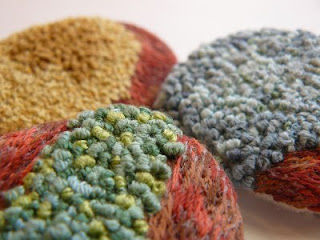Meliors' poem Ponting's Genius was the Tuesday Poem on my blog this week.
The photo above shows Meliors with a work called Sastrugi. Photo by Jody Saturday
Meliors, a simple question, but one that may have a complex answer: why are you so interested in Antarctica?
It is mysterious, dangerous, vulnerable and beautiful. The lack of flora and fauna (and pigments) focus our attention onto patterns and textures of snow and ice, sky and sea which I find very exciting to interpret visually. Its short, intense human history and its long, surprising natural history both provide thrilling stories that bear endless iterations. And ultimately at this distance, it's a blank canvas for the imagination.
If you had the chance to visit Antarctica, would you?
Um, this is tricky, because if I was offered an opportunity to go I would probably accept. But really I'm ambivalent. On one hand it would be amazing, inspiring and unlike anything else I could do. But on the other hand Antarctica is an incredibly vulnerable environment about which I am intensely concerned. I don't think Antarctica needs me as just another tourist, although I'm willing to be persuaded that I might have something of value to offer in exchange for a free ticket.
I spend a huge amount of time thinking about Antarctica and my imagination seems adequately fed through second hand sources. The compliments about my work that I treasure the most are from people who have spent time in Antarctica, who tell me I've captured the essence of the place.
And besides, its jolly cold and a bit scary down there.
You are both an artist and a poet, and for the Imagining Antarctica exhibition in Hamilton, you are giving a poetry reading / artist's talk as well as exhibiting visual art. How do the practice of art and the practice of poetry work side by side - and for that matter, how on Earth do you find the time to do both?
The Imagining Antarctica exhibition at ArtsPost
Ha! I don't really find time to do both. The past months of intensely preparing my exhibitions has been a poetry drought. Writing seems to be woven through my creative life in an irregular abstract way rather than as a disciplined practice. There are times when I write a lot, but more times when I write little or nothing. Last year was very productive though, and most of the poems I wrote then relate to the art I am showing now, hence the poetry reading and artist talk event.
Reading and looking at the entries on your excellent blog, I am struck by the hours and hours of work that goes into creating them. Can you describe your process of making them, such as the icebergs?
Most of the work I make these days starts with an old woven wool blanket which I cut into contour pieces. I needle felt each layer with a nice plump cover of unspun wool and then attach the layers together using blanket stitch. The icebergs are three dimensional, sculptural pieces so there's a lot of layers and a lot of needle felting to get the three-dimensionality.
I use a similar technique to make wall relief pieces which may use only a couple of layers of blanket and little or no felting, but can be much bigger and even more time consuming to make. My biggest work, 'My Antarctica' a scale relief map of the entire continent, took me about eight months to make. I can make a little iceberg in a week.
Meliors standing in front of My Antarctica. Photo: Marion Manson (ArtsPost)
Over time I have perversely chosen to make my stitching cruder (even though hundreds of hours of practice has made me a better stitcher). I want my work to look unmistakably handmade. With some of my earlier embroidered pieces viewers would assume it was machine stitched, and I decided I didn't want any ambiguity about that. I 'd rather have people saying 'I could make that' and so to consider what it means to stitch something by hand. I want people to contemplate the hours and hours that go into my making.
Why did you choose the craft medium, and these crafts in particular, to make your artworks (and, does the wording of that question imply a dichotomy that doesn't or shouldn't exist?)
Contemporary art is a very broad field in which there are lots of interesting craft practices to be seen. I choose craft as my means of creative expression both for the pleasure and the meaning of my making. Slow meditative hand stitching is very sensual and satisfying. By choosing hand made rather than machine made, and doing it myself rather than farming the work out to low paid women in Asia, my work implicitly critiques the economic as well as environmental impacts of industrialised consumerist culture.
You were recently in Melbourne for the opening of the "F**k Your Donation" exhibition, which includes your installation "Spoil". How was that experience, and is this part of a continuing involvement in the Australian arts scene?
Meliors' installation "Spoil" at "F**k Your Donation"
Melbourne is a fantastic city for the arts, and especially for craft practices in contemporary art. It is a real thrill to show in a gallery there for the first time, and have such an enthusiastic response to my work. I hope to go back for more soon.
One thing I know we have in common is our love for Kim Stanley Robinson's writing, and in particular his Mars trilogy. What's so great about those books?
Well, KSR's novel Antarctica turned me into a fan of Antarctica as well as speculative fiction when I first read it some 15 years ago. That book, and the Mars and Washington trilogies resonate with me as extremely plausible near-future-histories that aren't dystopias. I like his strong, complex female characters; frustratingly rare in the genre. I reread all seven novels reasonably regularly and I appreciate the detail as well as the broad sweep of his vision. But mostly because he's very good at making it seem possible that we 21st century humans could dig ourselves out of the dreadful mess our species has created, and I often feel the need for that spark of hope.
KSR's writing has had a huge influence on my visual, textile arts. For example I've turned again and again to his descriptions of the textures and colours of Antarctica as I've stitched. He's a wonderfully visual writer. In more direct homage, I once made a series of small embroidered 'Mars gardens', visualising the greening of the red planet as practised by Sax Russell and others in his trilogy.
Three of Meliors' "Mars Gardens", after Kim Stanley Robinson
Do you have any writing projects on the go that are separate from your art projects, and how do you see the balance between your art and your poetry developing in the future?
Right now I don't have any particular writing projects. Rather, I'm content to let occasional poems arise spontaneously, most often in very close relationship to the visual art I'm working on, particularly at the early, conceptual stages.
Are there particular artists and poets whose work you enjoy that you'd like to encourage readers of this interview to check out?
I'm pretty excited about sculptors Ruth Asawa (http://www.ruthasawa.com/) and Mandy Greer (http://stonemandy.wordpress.com/). I also recommend the photographs of Edward Burtynsky (http://www.edwardburtynsky.com/), and the fantastic video about his work called Manufactured Landscapes. Two of the poets I am enjoying most at the moment are Janis Freegard and Bernadette Hall.
Where people can see Meliors' work
- Until 19 September in Hamilton at ArtsPost Galleries, Victoria Street
- Blog, Bibliophilia: www.meliors.net
- Etsy Shop: www.etsy.meliors.com
- YouTube: www.youtube.com/meliors6
- Poetry to be found in Voyagers, the 2010 Rhysling Anthology, and Enamel issues 1 and 3 (forthcoming)








No comments:
Post a Comment